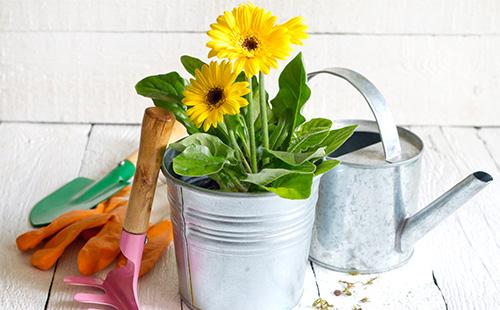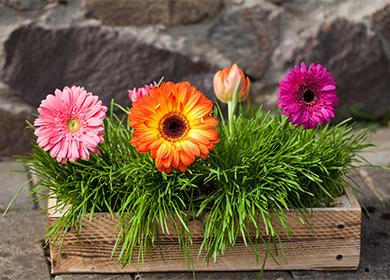The content of the article
Separate gerbera varieties have been developed for apartments. They adapt perfectly to the home microclimate, are easy to care for, and bloom easily. Bloom repeatedly over the year. Due to the simplicity of cultivation, they can be recommended to beginners in floriculture as a beautiful and unpretentious plant.
Appearance
Gerbera is a beautifully flowering perennial of the aster family. The flowers are large, the color is any color except blue. The leaves are elongated, cirrus-dissected, with a sharpening at the end. Form a compact, neat outlet. Many varieties have a slight pubescence in the lower part of the leaves and on the petioles. During flowering, produces high peduncles up to 70 cm long. There are no leaves on peduncles; inflorescences in the form of baskets are formed in the upper part.
In most indoor varieties, the diameter of the inflorescence does not exceed 15 cm. But there are varieties with very large inflorescences - up to 30 cm. Reed flowers are located along the edges of the basket, small tubular ones in the center. After flowering, achenes mature. Seeds remain viable for up to six months.
Popular varieties
Almost all indoor species are derived on the basis of Jameson's gerbera. They differ in compact size, unpretentiousness, a variety of colors. Breeding work continues to this day - the collection of indoor gerberas is replenished with new interesting varieties. By the signs of decorativeness, six groups of gerberas can be distinguished.
- Small flowered with narrow petals. The diameter of the flowers (inflorescences) does not exceed 9 cm. Varieties “Aldebaran” of intense pink hue and “Alkar” of the color of ripe cherry are interesting.
- Large-flowered with narrow petals. They call it the American type. The inflorescences are larger - up to 13 cm. Often grown "Vega" orange blossom. No less interesting are “Jupiter” of saturated sunny color and “Algol” shade of dark cherry.
- Large-flowered with medium sized petals. Inflorescences are medium in size. The most spectacular variety "Mars" muted red color.
- Large-flowered with wide petals. Large expressive inflorescences. Their size reaches 15 cm. Bright red “Delios”, “Markal” in juicy orange-yellow colors deserve special attention.
- Terry with narrow petals. Usually not very large - up to 11 cm. The Kalinka varieties of a sunny shade, the Viola of a deep pink color and the Sonya look pure red.
- Terry with wide petals. Large volume inflorescences. More often than others, the Iskra is grown in dark, dense red.
Room Gerbera Care: What to Consider
How to care for potted gerbera? It is enough to follow a number of simple rules, to create conditions for good lighting.In a favorable microclimate, the gerbera blooms at least twice a year.
- Lighting. Need full bright lighting. In summer, they are kept on the western and eastern windowsills. The rest of the time - in the south. In the heat, the leaves wilt - it is better to shade from the direct sun. In summer, it is useful to rearrange the balcony or garden. Protecting from drafts is optional.
- Temperature. Gerbera responds well to heat, but does not respond well to heat. In the flowering phase, a moderate temperature is maintained from 16 to 22 ° C. In winter, the rest phase begins. The temperature is reduced to 14–16 ° C, sharp jumps are avoided.
- Air humidity. It grows equally well in high and low humidity. Dry air provokes the appearance of a spider mite. Spraying the leaves is good for the flower.
- Watering. You need to water the gerbera indoor regularly. Drying does not tolerate well. Systematic waterlogging of the soil provokes fungal diseases. Use warm water - at least 18 ° C. Cold water is a common cause of illness.
- Top dressing. Often fed - every week. During the growth period, nitrogen fertilizers are used, the rest of the time - mineral complexes. The solution is made weak, the dosage is reduced by two to three times.
- The soil. Soil is made up of peat, sand, sheet land. The addition of shallow sphagnum is welcome. Gerbera reacts negatively to organic matter.
- Transfer. For the first time, it is advisable to transplant a gerbera house at home a couple of weeks after the purchase, when the period of adaptation passes. Then transplanted as necessary, when the former pot becomes small. Too voluminous pots are not used - gerbera in them grows leaves, but blooms reluctantly. The maximum volume of the pot is one and a half liters.

Flowering features
In nature, gerbera grows in areas where the daylight hours are constant, ranging from 12 to 14 hours. With reduced illumination, a room gerbera does not bloom.
In winter, flowering is stimulated by keeping warm and artificial lighting with phytolamps or fluorescent lamps. According to flower growers, the long absence of a dormant period greatly weakens the plant. It can lose its decorative effect much earlier than in three to four years. Too long daylight hours also impede flowering.
Gerbera retains decorativeness for a long time only if its natural flowering and dormancy cycle is observed. From the end of winter, it begins to grow, produce new leaves and peduncles. Flowering continues until June. Then comes a short rest period. The next wave of growth and the formation of buds is from August to late autumn. In winter, moderate temperatures are maintained no higher than 16 ° C.
Breeding methods
Propagation of room gerbera by seed and vegetative methods is practiced. Seeds germinate quickly, cuttings easily root. Every three years, new plants are grown to replace old ones. For beginners in floriculture, all methods of reproduction are given step by step.
Seed sowing
Features Indoor gerbera can be grown from seeds in order to propagate or grow a new variety. For propagation, you can use seeds from your plant. The first flowering will occur no earlier than 10 months. Seeds are sown in March in a mixture of turf and sand.
Action algorithm
- At the bottom of a low wide tank, pour a layer of soil mixture.
- Sprinkle the seeds on the surface, sprinkle on top with a layer of earth no more than 5 cm.
- Cover the container with plastic wrap, moisten the soil from the spray gun.
- Keep in a warm, well-lit place, ventilate and moisturize regularly.
- When the seedlings grow three to four real leaves, peek into separate cups or small pots. Transplant as you grow.
Bush division
Features An adult two to three year old plant can be planted. Healthy, strong bushes with several growth points are suitable for dividing. The first time after the division, the planted plants are kept under gentle conditions - regularly watered, shaded from bright light, and maintained at a moderate temperature. Enhanced care is provided until stable growth.
Action algorithm
- Remove the flower from the container, brush off the ground.
- Divide the bush into three to five parts. On each of them should remain two points of growth.
- Cut the roots - leave 10-15 cm.
- Pour the soil into the pot, drop off the pieces, so that the outlet rises about 1 cm above the surface.

Frequent diseases
Gerberas are unstable to disease. Infection can occur through poor-quality soil, from other colors. A plant purchased in a store may be initially infected. Illnesses are aggravated by improper care. The table shows the main diseases of gerbera, their signs and methods of treatment.
Table - Gerbera Diseases
| Title | Main symptoms | Treatment methods |
|---|---|---|
| Alternariosis (fungus) | - Red brownish spots; - the central part of the spots brightens; - velvety dark coating; - yellowing of leaves | - Treatment with drugs "Ridomil Gold", "Fitosporin" |
| Mosaic (virus) | - Yellow-green spots with clear boundaries; - leaf deformation; - vein pigmentation; - signs of necrosis | - Preventive treatment with fungicides; - destruction of a diseased plant |
| Powdery mildew (fungus) | - White coating on petioles of leaves; - spread of plaque; - drying of the plant | - Decrease in humidity; - spraying with drugs "Fundazol", "Topaz" |
| Gray rot (fungus) | - Withering of flowers and leaves; - gray coating | - Decrease in air humidity; - spraying with drugs "Fundazol", "Rovral" |
| Sclerotiniosis (fungus) | - Withering gerbera; - sunken spots at the base of the leaves and peduncles; - gray or white plaque | - Transplantation into light soil; - reduction of watering; - treatment with drugs "Fundazol", "Vitaros" |
| Late blight (fungus) | - Drying of the first external, then the internal leaves of the outlet; - rotting of the roots; - gerbera death | - Stopping watering; - the addition of dry soil; - the use of fungicides "Ridomil", "Profit Gold", "Previkur" |
Pests
Pests appear mainly when kept in adverse conditions, in the vicinity of infected plants. As a preventive measure, moderate (not low) air humidity is maintained, the flower is periodically sprayed with low doses of insecticides. Information about the main pests is given in the table.
Table - Gerbera Pests
| Insect name | Signs | Ways to fight |
|---|---|---|
| Aphid | - Twisting of young leaves; - sticky coating; - gerbera leaves turn yellow leaves | - Washing leaves with soapy water; - spraying with tobacco dust infusion; - use of specialized insecticides |
| Thrips | - Yellow and pink spots; - holes on the petals; - black dots on the leaves; - silver shade of leaves | - Spraying with preparations "Actellik", "Decis-Extra" |
| Spider mite | - Small white dots on the leaves; - drying, falling leaves; - spider web | - Spraying with the preparations “Vermitek” or “Fitoverm” |
| Whitefly | - tan color of leaves and petals | - Spraying with the drug "Mospilan" |
Since caring for the room gerbera is quite simple, it quickly became a popular potted plant. There are a lot of varieties and colors, but when choosing a variety, keep in mind that garden varieties are not suitable for growing in an apartment.

